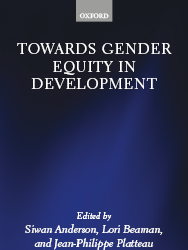Book
Towards Gender Equity in Development
This is an open access title available under the terms of a CC BY-NC-SA 3.0 IGO licence. It is free to read at Oxford Scholarship Online and offered as a free PDF download from OUP and selected open access locations.
As a result of widespread mistreatment and overt discrimination, women in the developing world often lack autonomy. Towards Gender Equity in Development brings together leading scholars working on gender issues to explore key sources of female empowerment and discuss the current challenges and opportunities for the future.
Exploring three key domains, this book adopts a clear multi-disciplinary approach to present different perspectives from gender-focused economics and social research. It covers marriage and women's relative bargaining position within the household; the options available to women outside of marriage and in the context of their community; and overarching discriminatory laws and cultural norms. It engages with questions of how marriage, divorce, and remarriage practices have evolved and with what effects for women; how female empowerment can benefit from improving options and economic and collective action opportunities; and how the government can act as a lawmaker to contribute to modifying norms and practices that disadvantage women.
 Join the network
Join the network